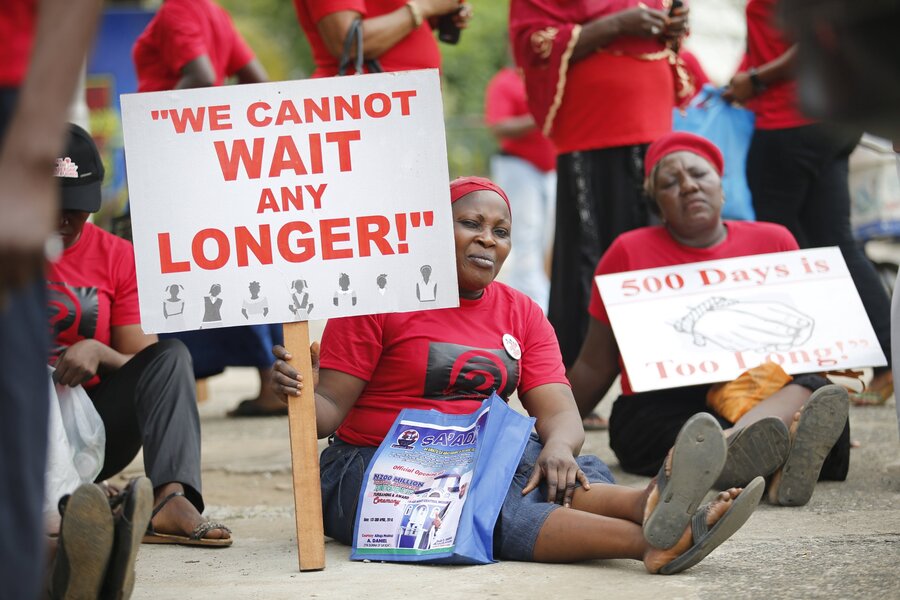Why the Boko Haram schoolgirls video got a cautious response
Loading...
It was a wrenching moment: Mothers watching a video of their daughters, kidnapped by Boko Haram militants, pleading to be rescued.
The video's release Thursday thrust the plight of 219 missing school girls back into the headlines, capping a week of news that reminded many of the peril children face in the conflict.
On Tuesday, UNICEF detailed a spike in the number of young girls Boko Haram is using as suicide bombers. That was followed by rallies that drew hundreds in major Nigerian cities to call for greater government efforts to find the girls. Then came the so-called proof-of-life video, demanded by government negotiators who are trying to secure the girls’ release.
For the many parents still searching and hoping to be reunited with children abducted by Boko Haram, the militant Nigerian group that has roiled Northern Nigeria and its neighbors since 2009, it was a challenging week – but also one that served to renew international calls to rescue them.
After two years of unfulfilled government promises of their imminent rescue, the new video has been met with cautious expectations. One expert pointed to a number of hurdles that influence that caution, including the Nigerian government's shortcomings, Western biases about Africa, and the world’s short attention span.
“I don’t want people to only be interested in the Chibok girls every April. I think that there are 11 months a year that we need to be equally worried and concerned about getting the girls back to their families, safe,” says Mia Bloom a professor of communication at Georgia State University who’s written extensively on Boko Haram and their exploitation of women and girls.
The video, obtained by CNN, shows 15 of the Chibok girls wearing hijabs, with one issuing a scripted statement saying the girls are doing well and urging the Nigerian government to cooperate with Boko Haram so they can get back to their families. The video was shown to three mothers who were able to identify some as their own daughters and vouch that others had attended the school.
Shortly after the girls were abducted by Boko Haram fighters on April 14, 2014, from the Government Girls Secondary School in Chibok, a global campaign with the hashtag #bringbackourgirls launched. Public figures like Michelle Obama, Malala Yousafzai, and Ellen Degeneres loaned their voices and social media clout to boost its profile. But attention soon faded when they weren’t found.
That has been the case for many of the Boko Haram abductions, although the Chibok girls at least stirred up the debate. Later in 2014, the kidnapping of nearly 400 women and children in the northeastern Nigerian town of Damasak, which included a massacre of hundreds villagers, went virtually unnoticed, according to Human Rights Watch. The abducted remain unaccounted for.
“There is an unfortunate assumption of, ‘well that’s Africa, that’s how they do it,’” Professor Bloom says, adding that the fact that an unspecified number of the Chibok girls were Christian might add weight to American attention.
But Western reaction has not been all bluster and bias. The US, for one, has provided Nigerian forces support, including drone surveillance of the Sambisa Forest area where Boko Haram is headquartered, as well as information and reconnaissance assistance. Gordon Brown, the United Nations Special Envoy for Global Education, used the two-year anniversary of the Chibok abduction to renew calls for the UN Security Council to act urgently to protect children across the world.
"The Chibok girls are now a symbol of our apparent weakness to protect young lives," Mr. Brown said in a statement.
Nigerian President Muhammadu Buhari’s government has faced the bulk of domestic and international pressure to ramp up his efforts to end the insurgency and find the girls. This might have added to a tendency to overpromise on both fronts.
President Buhari’s election as president in March last year came with pressure to do far better than his heavily criticized predecessor Goodluck Jonathan.
Buhari ambitiously vowed to end the insurgency by December 2015. He declared them “technically defeated” after government forces recaptured an unspecified amount of Boko Haram territory, and because the group’s capacity to engage the military in traditional warfare was largely curtailed.
However, this corresponded with a rise in the group’s suicide attacks on soft targets, and the use of children, particularly girls, to conduct them. Since the abduction, there have been at least two instances in which the government has claimed the girls were about to be released in exchange for Boko Haram fighters, but when this didn’t eventuate, public disappointment grew.
Bloom points to how the government could use the suicide attacks to at least try to ascertain the welfare of the missing 219.
“On a number of occasions when there is a female or a young girl who is a suicide bomber, they’re not keeping records of who it is or trying to find out what the girl’s name is or the identity of the girl, because in doing so at least we could cross list what we know of the 276 from Chibok who were abducted,” she says.
“We don’t know if there’s a correlation between the girls who’ve been abducted and the over 90 female suicide bombers since 2014.”
Two of the mothers, Rifkatu Ayuba and Mary Ishaya, said they had recognized their daughters in the video while a third mother, Yana Galang, identified five of the missing girls, according to Reuters.
"The girls were looking very, very well," Ms. Galang said after viewing the video.
The video’s metadata, analyzed by CNN, suggests it was filmed on Christmas Day last year. A Reuters report indicated that the leak of the video may have angered both Boko Haram and the government, potentially threatening negotiations to secure the girls’ release. In another possible scenario, Bloom says the militants could have filmed the video with intent to piggyback on the publicity they knew would surround the anniversary.
The Nigerian government responded to its release saying it still had to determine its authenticity.
Galang said the mothers just want their daughters back.
"They were definitely our daughters ... all we want is for the government to bring back our girls."






